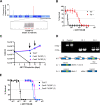Veterinary trypanocidal benzoxaboroles are peptidase-activated prodrugs
- PMID: 33141865
- PMCID: PMC7710103
- DOI: 10.1371/journal.ppat.1008932
Veterinary trypanocidal benzoxaboroles are peptidase-activated prodrugs
Abstract
Livestock diseases caused by Trypanosoma congolense, T. vivax and T. brucei, collectively known as nagana, are responsible for billions of dollars in lost food production annually. There is an urgent need for novel therapeutics. Encouragingly, promising antitrypanosomal benzoxaboroles are under veterinary development. Here, we show that the most efficacious subclass of these compounds are prodrugs activated by trypanosome serine carboxypeptidases (CBPs). Drug-resistance to a development candidate, AN11736, emerged readily in T. brucei, due to partial deletion within the locus containing three tandem copies of the CBP genes. T. congolense parasites, which possess a larger array of related CBPs, also developed resistance to AN11736 through deletion within the locus. A genome-scale screen in T. brucei confirmed CBP loss-of-function as the primary mechanism of resistance and CRISPR-Cas9 editing proved that partial deletion within the locus was sufficient to confer resistance. CBP re-expression in either T. brucei or T. congolense AN11736-resistant lines restored drug-susceptibility. CBPs act by cleaving the benzoxaborole AN11736 to a carboxylic acid derivative, revealing a prodrug activation mechanism. Loss of CBP activity results in massive reduction in net uptake of AN11736, indicating that entry is facilitated by the concentration gradient created by prodrug metabolism.
Conflict of interest statement
The authors have declared that no competing interests exist.
Figures





References
-
- O'Neill J. Tackling drug-resistant infections globally: final report and recommendations—The review on antimicrobial resistance. 2016. Available from: https://amr-review.org/sites/default/files/160518_Final%20paper_with%20c...
-
- Swallow BM. Impacts of trypanosomiasis on African agriculture. PAAT Technical and Scientific Series 2, FAO, Rome: 2000.
Publication types
MeSH terms
Substances
Grants and funding
LinkOut - more resources
Full Text Sources
Molecular Biology Databases

